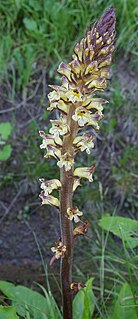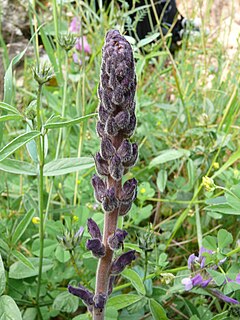
Orobanche, commonly known as broomrape, is a genus of over 200 species of small parasitic herbaceous plants, mostly native to the temperate Northern Hemisphere. It is the type genus of the broomrape family Orobanchaceae.

Orobanche uniflora, commonly known as one-flowered broomrape, one-flowered cancer root, ghost pipe or broomrape, is an annual parasitic herbaceous plant. It is native to much of North America, where it is a parasitic plant, tapping nutrients from many other species of plants, including those in the families Asteraceae and Saxifragaceae and in the genus Sedum. The name "orobanche" can be translated to "vetch-strangler" and "uniflora" can be translated to "single-flower".

Orobanche californica, known by the common name California broomrape, is a species of broomrape. It is a parasitic plant growing attached to the roots of other plants, usually members of the Asteraceae.

Orobanche parishii is a species of broomrape known by the common names Parish's broomrape and short-lobed broomrape. It is native to the coast and mountains of California and Baja California, where it is a parasite growing attached to the roots of other plants, usually shrubs of the Asteraceae, such as Menzies' goldenbush. This plant produces usually one thick, hairy, glandular, pale yellowish stem up to about 26 centimetres (10 in) tall. As a parasite taking its nutrients from a host plant, it lacks leaves and chlorophyll. The inflorescence is a dense cluster of flowers accompanied by dark-veined oval bracts. Each flower has a calyx of triangular sepals and a tubular corolla roughly 2 centimetres (0.8 in) long, pale brownish or pinkish in color with red veining.

Orobanche rapum-genistae, the greater broomrape, is a plant species in the genus Orobanche. It is a parasitic plant, native to Europe, growing on the roots of plants in the bean family, usually common broom or European gorse.

Orobanche hederae, the ivy broomrape, is, like other members of the genus Orobanche, a parasitic plant without chlorophyll, and thus totally dependent on its host, which is ivy. It grows to 60 cm (2 ft), with stems in shades of brown and purple, sometimes yellow. The flowers are 10–22 mm (0.4–0.9 in) long, cream in colour with reddish-purple veins.

Orobanche reticulata is a species of broomrape known by the common name thistle broomrape. It is a parasitic plant whose host is normally the creeping thistle. It is native to the lowlands of Western Europe and Central Asia, but in the United Kingdom it is a rare and protected plant, growing only in Yorkshire, on grassland sites such as Quarry Moor.
Orobanche mutelii, the dwarf broomrape, is a species of plant in family Orobanchaceae. It is endemic to Malta.
Hypericum australe is a species of plant in the family Hypericaceae. Individuals can grow to 24 cm tall.

Matricaria aurea is a species of plants in the family Asteraceae.
Orobanche canescens is a species of herb in the family Orobanchaceae. Individuals can grow to 0.4 m.

Orobanche caryophyllacea is a plant species in the family Orobanchaceae.
Orobanche clausonis is a species of plant in the family Orobanchaceae.

Orobanche lavandulacea is a species of plant in the family Orobanchaceae.

Orobanche picridis is a species of plant in the family Orobanchaceae.

Orobanche pubescens is a species of annual herb in the family Orobanchaceae. They have a self-supporting growth form. Individuals can grow to 0.17 m.
Orobanche sanguinea is a species of herb in the family Orobanchaceae. Individuals can grow to 0.17 m.
Phelipanche nana is a plant species in the family Orobanchaceae.

Polypogon viridis, the beardless rabbitsfoot grass, is a species of perennial grass in the family Poaceae. They have a self-supporting growth form and simple, broad leaves. Individuals can grow to 0.43 m.

Trifolium scabrum, the rough clover, is a species of annual herb in the family Fabaceae. They have a self-supporting growth form and compound, broad leaves. Individuals can grow to 0.12 m.













